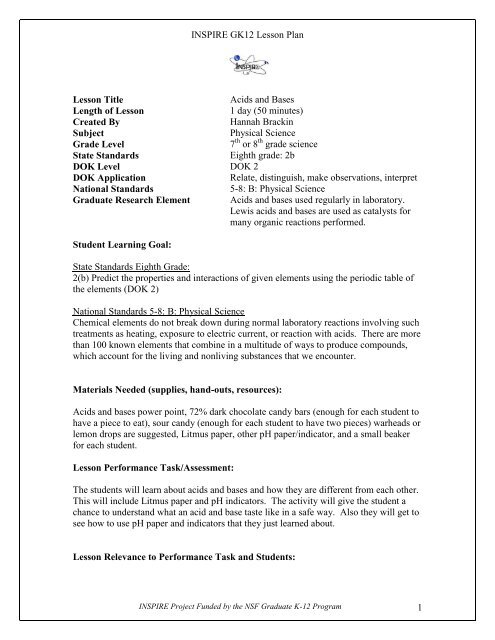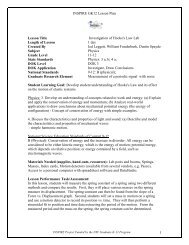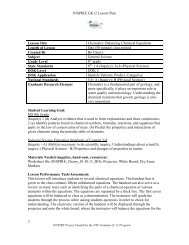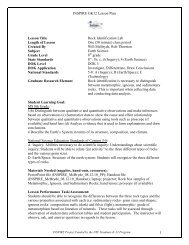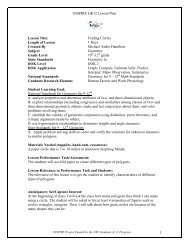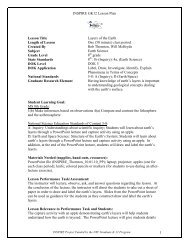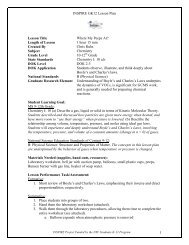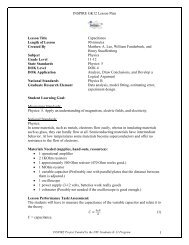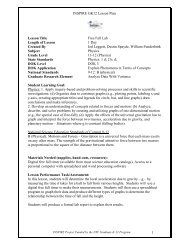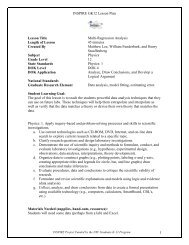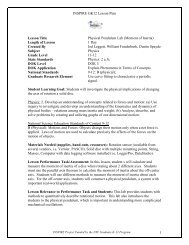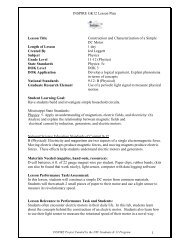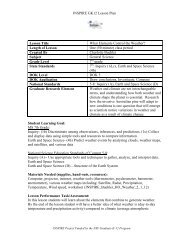Acids and Bases
Acids and Bases
Acids and Bases
You also want an ePaper? Increase the reach of your titles
YUMPU automatically turns print PDFs into web optimized ePapers that Google loves.
INSPIRE GK12 Lesson Plan<br />
Lesson Title<br />
<strong>Acids</strong> <strong>and</strong> <strong>Bases</strong><br />
Length of Lesson<br />
1 day (50 minutes)<br />
Created By<br />
Hannah Brackin<br />
Subject<br />
Physical Science<br />
Grade Level<br />
7 th or 8 th grade science<br />
State St<strong>and</strong>ards<br />
Eighth grade: 2b<br />
DOK Level DOK 2<br />
DOK Application<br />
Relate, distinguish, make observations, interpret<br />
National St<strong>and</strong>ards<br />
5-8: B: Physical Science<br />
Graduate Research Element <strong>Acids</strong> <strong>and</strong> bases used regularly in laboratory.<br />
Lewis acids <strong>and</strong> bases are used as catalysts for<br />
many organic reactions performed.<br />
Student Learning Goal:<br />
State St<strong>and</strong>ards Eighth Grade:<br />
2(b) Predict the properties <strong>and</strong> interactions of given elements using the periodic table of<br />
the elements (DOK 2)<br />
National St<strong>and</strong>ards 5-8: B: Physical Science<br />
Chemical elements do not break down during normal laboratory reactions involving such<br />
treatments as heating, exposure to electric current, or reaction with acids. There are more<br />
than 100 known elements that combine in a multitude of ways to produce compounds,<br />
which account for the living <strong>and</strong> nonliving substances that we encounter.<br />
Materials Needed (supplies, h<strong>and</strong>-outs, resources):<br />
<strong>Acids</strong> <strong>and</strong> bases power point, 72% dark chocolate c<strong>and</strong>y bars (enough for each student to<br />
have a piece to eat), sour c<strong>and</strong>y (enough for each student to have two pieces) warheads or<br />
lemon drops are suggested, Litmus paper, other pH paper/indicator, <strong>and</strong> a small beaker<br />
for each student.<br />
Lesson Performance Task/Assessment:<br />
The students will learn about acids <strong>and</strong> bases <strong>and</strong> how they are different from each other.<br />
This will include Litmus paper <strong>and</strong> pH indicators. The activity will give the student a<br />
chance to underst<strong>and</strong> what an acid <strong>and</strong> base taste like in a safe way. Also they will get to<br />
see how to use pH paper <strong>and</strong> indicators that they just learned about.<br />
Lesson Relevance to Performance Task <strong>and</strong> Students:<br />
INSPIRE Project Funded by the NSF Graduate K-12 Program 1
INSPIRE GK12 Lesson Plan<br />
Students will be taught the properties of acids <strong>and</strong> bases. They will learn about the<br />
different indicators that can be used to test <strong>and</strong> interpret whether a substance is an acid or<br />
base. Once the material has been covered, the students will discover what an acid <strong>and</strong> a<br />
base taste like <strong>and</strong> have a chance to use some of the indicators that were just covered.<br />
Anticipatory Set/Capture Interest:<br />
Caught Red H<strong>and</strong>ed Demo (See Teacher’s Notes)<br />
Guided Practice:<br />
At the start of class, the teacher will ask students what they know about acids <strong>and</strong> bases.<br />
This will give the teacher an idea of what the students know <strong>and</strong> a chance to help with<br />
misconceptions. The teacher will then begin covering the properties of acids <strong>and</strong> bases.<br />
<strong>Acids</strong><br />
<strong>Bases</strong><br />
Taste sour<br />
Taste bitter<br />
Compound with a pH below 7 Compounds with a pH above 7<br />
Ionizes water to produce hydrogen ions<br />
H +<br />
Proton acceptor when dissolved in water, it<br />
will produce a hydroxide ion<br />
OH -<br />
Proton donor<br />
Proton acceptor<br />
Reacts with metals to produce hydrogen Emulsify fats <strong>and</strong> oils<br />
gas<br />
React with bases to form salts <strong>and</strong> water<br />
Reacts with limestone to produce carbon<br />
dioxide<br />
Corrosive<br />
Slippery to the touch<br />
List common examples of acids (hydrochloric acid, sulfuric acid, acetic acid, <strong>and</strong> citric<br />
acid) <strong>and</strong> bases (NaOH, NH 4 OH, <strong>and</strong> soap) that the students would encounter.<br />
Next, the teacher will go over the pH scale <strong>and</strong> how it works. Make sure to tell the<br />
students that pH st<strong>and</strong>s for “Potential for Hydrogen”. It would be beneficial to show the<br />
students scales that have examples of substances that they will recognize at every pH.<br />
Finally, the teacher will cover litmus paper <strong>and</strong> how it is used. <strong>Acids</strong> turn blue to red <strong>and</strong><br />
bases turn red to blue. The teacher can then cover other acid/base indicators that the<br />
student might see throughout the year. One such example would be phenolphthalein,<br />
which is colorless in acidic solution <strong>and</strong> pink in basic solution.<br />
Once the material has been covered, the students will participate in an activity. Each<br />
student will be given a piece of 72% dark chocolate <strong>and</strong> two pieces of sour c<strong>and</strong>y. Each<br />
INSPIRE Project Funded by the NSF Graduate K-12 Program 2
INSPIRE GK12 Lesson Plan<br />
student will eat the chocolate <strong>and</strong> decide whether or not it tastes like an acid or a base. It<br />
should taste bitter like a base. Next, the students will be asked to eat one piece of the<br />
sour c<strong>and</strong>y. They should identify whether it tastes like an acid or a base. It should taste<br />
sour like an acid. The students will then take the other piece of sour c<strong>and</strong>y <strong>and</strong> place it in<br />
10mL of water until the sour dust dissolves <strong>and</strong> then remove it from the solution. The<br />
students will then use two different types of pH paper to test the pH of the c<strong>and</strong>y by<br />
dipping the paper into the water solution.<br />
Independent Practice:<br />
The students will have to taste chocolate <strong>and</strong> sour c<strong>and</strong>y <strong>and</strong> identify whether they would<br />
be classified as an acid or base. They will then use the indicators <strong>and</strong> pH paper to test<br />
their hypothesis.<br />
Remediation <strong>and</strong>/or Enrichment:<br />
Remediation:<br />
Individual IEP. After the students taste the c<strong>and</strong>y, have the teacher test the indicators <strong>and</strong><br />
show the students the results.<br />
Enrichment:<br />
The students could then test other common materials such as shampoo, food, <strong>and</strong><br />
chemicals using the pH paper <strong>and</strong> indicators.<br />
Check(s) for Underst<strong>and</strong>ing:<br />
After showing the pH scale the students will be shown another that lists examples of<br />
substances at each pH level. Ask the students questions such as: Why is saliva (pH 6)<br />
slightly acidic? They should be able to reason that this is because it starts our digestion<br />
process.<br />
What acid do we have in our stomach? Why does it not hurt or eat through our stomach<br />
lining?<br />
After what we have learned about pH today, what do you think pH st<strong>and</strong>s for? (potential<br />
of Hydrogen)<br />
Closure:<br />
INSPIRE Project Funded by the NSF Graduate K-12 Program 3
INSPIRE GK12 Lesson Plan<br />
The students will demonstrate how to use the pH indicators that they just learned about<br />
when preforming the test on the sour c<strong>and</strong>y.<br />
Possible Alternate Subject Integrations:<br />
Biology: Buffers <strong>and</strong> physiological pH of the body.<br />
Teacher Notes:<br />
http://sites.google.com/site/chemistrydemos/7--chemcial-reaction/acid-base<br />
INSPIRE Project Funded by the NSF Graduate K-12 Program 4


